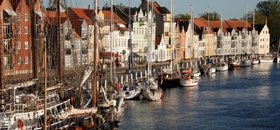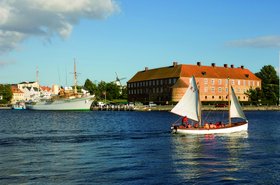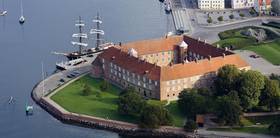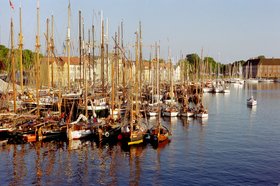Sønderborg (Sonderborg) is an old town with a population of 27,000 I is located in Southern Denmark close to the German border and it has been at the center of many important events in Denmark’s history.
Sønderborg was founded in 1256 and is beautifully situated at the coast on both sides of Alssund (Als Sound) linked together with two bridges. The town grew up around Sønderborg Castle, which was founded during the 1200. Sønderborg is well-known for the castle and for the recurring “Tilting-at-the-Ring”. To many visitors it is a green holiday island, with a coastline perfect for swimming, sailing and fishing.
Tuesday 29 August we will visit Sønderborg Castle which also houses the Museum of Southern Jutland. The castle and its museum cover the history and culture of Sønderborg and the border region from the Middle Ages to the present with a focus on Danish-German conflicts during the Schleswig wars of 1848-50 and 1864 and the First World War. The museum also hosts exhibitions on navigation, textiles and handicrafts and holds a small art collection with works by Southern Jutland painters.
Sønderborg Castle was founded by the Danish king, Valdemar the Great, in 1158 as a fortified tower to provide protection against attacks by the Wends (a historical name for Slavs living along the southern coast of the Baltic Sea). Around 1350, the castle was expanded significantly with an addition of the Blue Tower and with the construction of massive outer walls. In 1490, the fortress became the property of the Crown. Both King Hans and his son Christian II extended Sønderborg Castle and made it into one of the country's strongest fortresses.
Following the the Middle Ages, the castle was rebuilt in 1550-1560 as a Renaissance complex. The castle chapel, Queen Dorothea’s Chapel – is today one of Europe’s few preserved princely chapels from the Reformation, and houses Denmark’s oldest pure Renaissance interior.
Christian II (1481 – 1559) reigned as King of Denmark and Norway from 1513 until 1523 and also of Sweden, but only for one year, 1520-1521. He belonged to the House of Oldenburg, one of Europe's most influential royal houses of North German origin. Denmark was then an elective monarchy in which the nobility elected the new king, who had to share his power with them. His reign in Denmark and Norway was cut short when his uncle deposed him and took the thrones as Frederick I. Christian was then exiled to the Netherlands, then ruled by his brother-in-law, Holy Roman Emperor Charles V. After attempting to reclaim the thrones in 1531, he was lured into an ambush, arrested and held in captivity for the rest of his life, first in Sønderborg Castle for 17 years and afterwards at the castle of Kalundborg. Legend would have it that he was confined to the Blue Tower, but in reality he was probably allowed freedom of movement within the outer walls.
Under Christian III, in the mid-16th century, the castle was modified and converted into a four-wing castle. After the war of 1864, the province and the castle became German. On reunion after WW II in 1920, the Danish state acquired the castle, which came to house a museum of Southern Jutland history.
After Christian III's death in 1559, Hercules von Oberberg built the unique castle chapel in 1568-70 for Queen Mother Dorothea. After Dorothea's death the castle passed into the ownership of the Dukes of Southern Jutland until 1667, when it became a Danish estate and was more or less unused until 1718.
In 1718-26, Frederik IV had the castle rebuilt in baroque style by the contractor general Wilhelm von Platen. New roofs and windows were installed in straight, even rows. In 1755, the Blue Tower was demolished and in 1764 the castle passed into the hands of the local dukes again and was rented out as a warehouse. After 1864, the castle became Prussian property and served as army barracks until reunification in 1920.
The last owner, Duke Ernst Günther, allowed Sønderborg County Museum to move into a part of the castle in 1920. The Danish state took over the castle in 1921 and allowed several institutions to use it as long as they paid heed to the expanding museum.
The castle was restored in 1964-73 and returned to its Baroque style originating from Frederik IV in the 1720s. Sønderborg Castle is today owned by the Danish state.
You can read more about the castle, the collections and the history of the region here.




